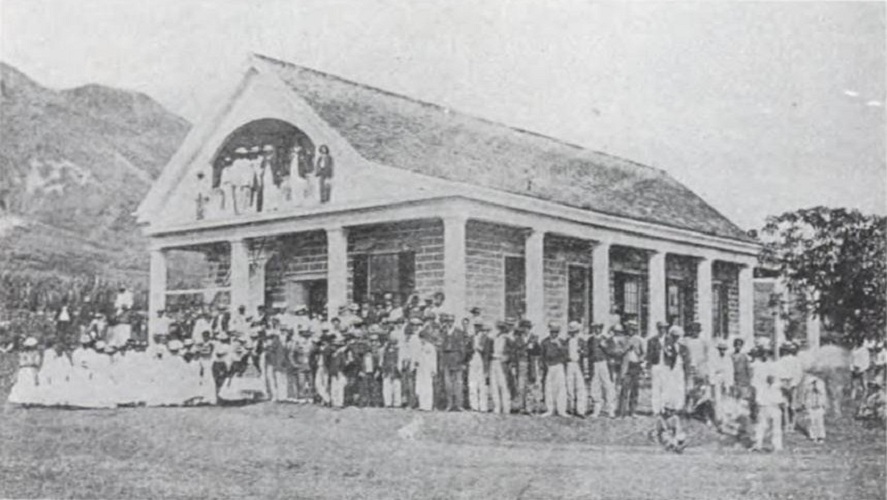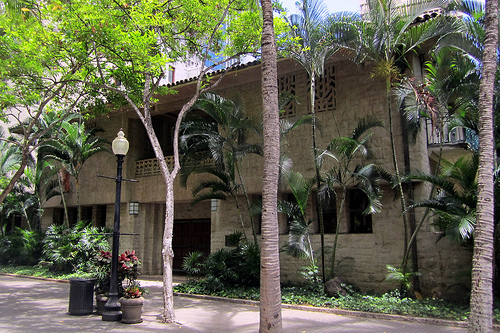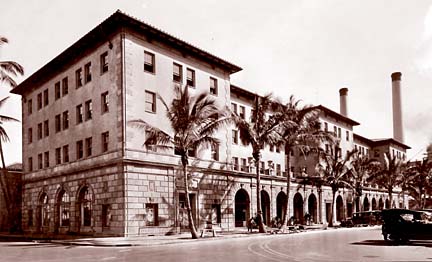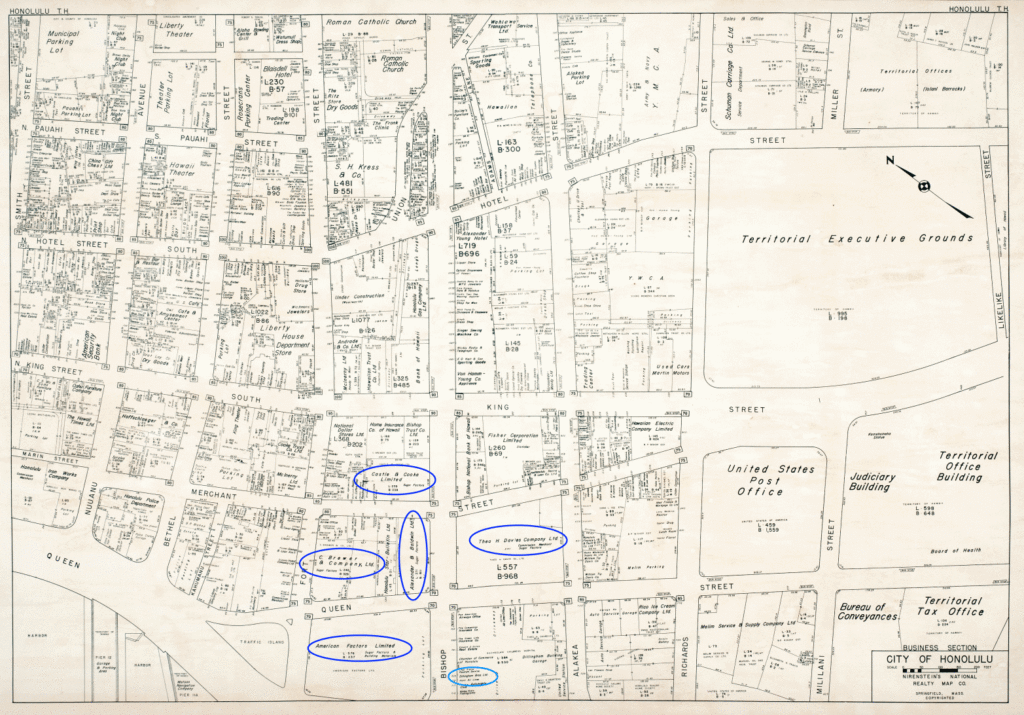Born January 25, 1822 in Glens Falls, New York, Charles Reed Bishop was an orphan at an early age and went to live with his grandparents on their 120-acre farm learning to care for sheep, cattle and horses and repairing wagons, buggies and stage coaches. Academically, he only attended the 7th and 8th grades at Glens Falls Academy, his only years of formal schooling.
After leaving school, he becomes a clerk for Nelson J. Warren, the largest business in Warrensburgh, New York. He learned bartering, bookkeeping, taking inventory, maintenance and janitorial duties. Bishop became an expert in barter, and ran the post office, lumber yard and farm. He becomes a capable businessman.
By January 1846, Bishop was ready to broaden his horizons. He and a friend, William Little Lee, planned to travel to the Oregon territory, Lee to practice law and Bishop to survey land. They sailed aboard the ‘Henry’ from Newburyport, Massachusetts, around Cape Horn on the way to Oregon.
The vessel made a stop in Honolulu on October 12, 1846; both decided to stay. (Lee later became the first Chief Justice of the Supreme Court for the Kingdom of Hawaiʻi.)
Bishop soon found work, first at Ladd and Company, a mercantile and trading establishment, then at the US Consulate in Honolulu. In 1849, Bishop signed an oath to “support the Constitution and Laws of the Hawaiian Islands” and was appointed collector of customs for the kingdom.
Bishop met Bernice Pauahi while she was still a student at the Chiefs’ Children’s School (they probably met during the early half of 1847,) and despite the opposition of Pauahi’s parents who wanted her to marry Lot Kapuāiwa (later, Kamehameha V,) Bishop courted and married Pauahi in 1850. (His letters that mention Pauahi reveal a deep respect and affection for his wife and suggest she was a major source of his happiness throughout their 34-year marriage.)
Their home, Haleakala, became the “greatest centre of hospitality in Honolulu.” They graciously hosted royalty, visiting dignitaries, friends and neighbors as well as engaged in civic activities such as organizing aid to the sick and destitute and providing clothing for the poor.
Bishop was primarily a banker (he has been referred to as “Hawaiʻi’s First Banker.”) An astute financial businessman, he became one of the wealthiest men in the kingdom from banking, agriculture, real estate and other investments.
However, his industrious nature and good counsel in many fields were also highly valued by Hawaiian and foreign residents alike. He was made a lifetime member of the House of Nobles and appointed to the Privy Council. He served Kings Kamehameha IV, Kamehameha V, Lunalilo and Kalākaua in a variety of positions such as: foreign minister; president of the board of education; and chairman of the legislative finance committee.
Bishop believed in the transforming power of education and supported a number of schools: Punahou, Mills Institute (now known as Mid–Pacific Institute), St Andrews Priory and Sacred Hearts Academy. He not only contributed money to his causes, he provided sound advice and financial expertise.
He even sent presents of food or clothing to schools like Kawaiahaʻo Seminary at Christmas, “It is my wish that Mr. Raupp should send them plenty of mutton…also that they should have two turkeys or some ducks, some oranges and cakes…”
Next to her royal lineage, no other aspect of Pauahi’s life was as important to her fulfillment as a woman – and as the founder of the Kamehameha Schools – as her marriage to Charles Reed Bishop. He brought her the love and esteem she needed as a woman and the organizational and financial acumen she needed to ensure the successful founding of her estate. (Kanahele)
Soon after Pauahi’s death in 1884 he wrote: “I know you all loved her, for nobody could know her at all well and not love her. For myself I will only say that I am trying to bear my loss and my loneliness as reasonably as I can looking forward hopefully to the time when I shall find my loved one again.”
Immediately after Pauahi’s death, Bishop, as one of first five trustees she selected to manage her estate and co-executor of her will, set in motion the process that resulted in the establishment of the Kamehameha Schools in 1887. (The other initial trustees were Charles Montague, Samuel Mills Damon, Charles McEwen Hyde and William Owen Smith.)
Because Pauahi’s estate was basically land rich and cash poor, Bishop contributed his own funds for the construction of several of the schools’ initial buildings on the original Kalihi campus: the Preparatory Department facilities (1888,) Bishop Hall (1891) and Bernice Pauahi Bishop Memorial Chapel (1897.)
Bishop is best known for his generous contributions to his wife’s legacy, the Kamehameha Schools (when he died, he left most of his estate to hers,) and the founding of the Bernice Pauahi Bishop Museum (1889.)
In a letter to Samuel Damon, 1911, he noted, “Being interested in her plans…I decided to carry out her wishes regarding the schools and promised to do something toward a museum of Hawaiian and other Polynesian objects…in order to accomplish something quickly … I soon reconveyed to her estate the life interests given by her will and added a considerable amount of my own property…”
In 1894, Bishop left Hawai`i to make a new life in San Francisco, California. Until he died, he continued, through correspondence with the schools’ trustees, to guide the fiscal and educational policy-making of the institution in directions that reinforced Pauahi’s vision of a perpetual educational institution that would assist scholars to become “good and industrious men and women.” (Bernice Pauahi Bishop’s Will, 1883)
In 1895, Bishop established the Charles Reed Bishop Trust. The beneficiaries of the Trust consist of 8-designated entities: Bernice Pauahi Bishop Museum, Maunaʻala, Central Union Church, Kaumakapili Church, Kawaiahaʻo Church, Kamehameha Schools, Mid-Pacific Institute (his original beneficiaries, Kawaiahaʻo Female Seminary and Mills Institute merged in 1907 to form Mid-Pac) and Lunalilo Trust.
By the time Pauahi died in 1884, Maunaʻala, the Royal Mausoleum in Nuʻuanu was crowded with caskets. Bishop built an underground vault for Pauahi and members of the Kamehameha dynasty.
Charles Reed Bishop died June 7, 1915; his remains rest beside his wife in the Kamehameha Tomb. A separate monument to Charles Reed Bishop was built at Maunaʻala in 1916. (Lots of information here is from KSBE.)































































